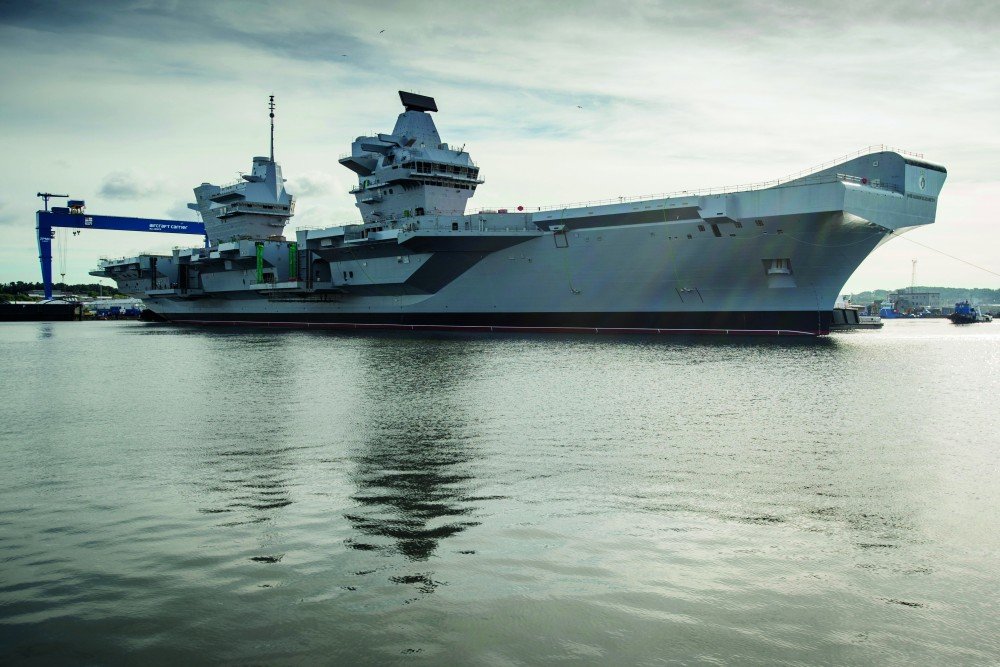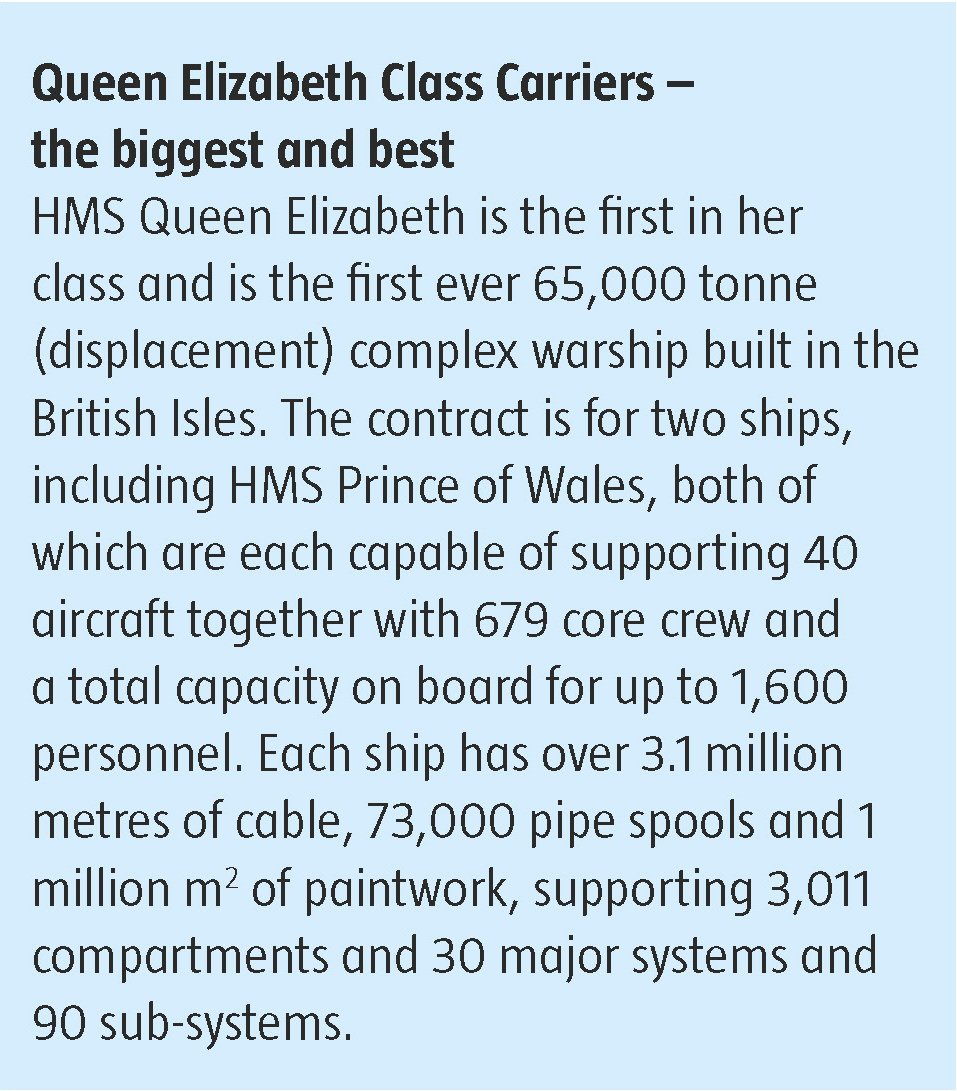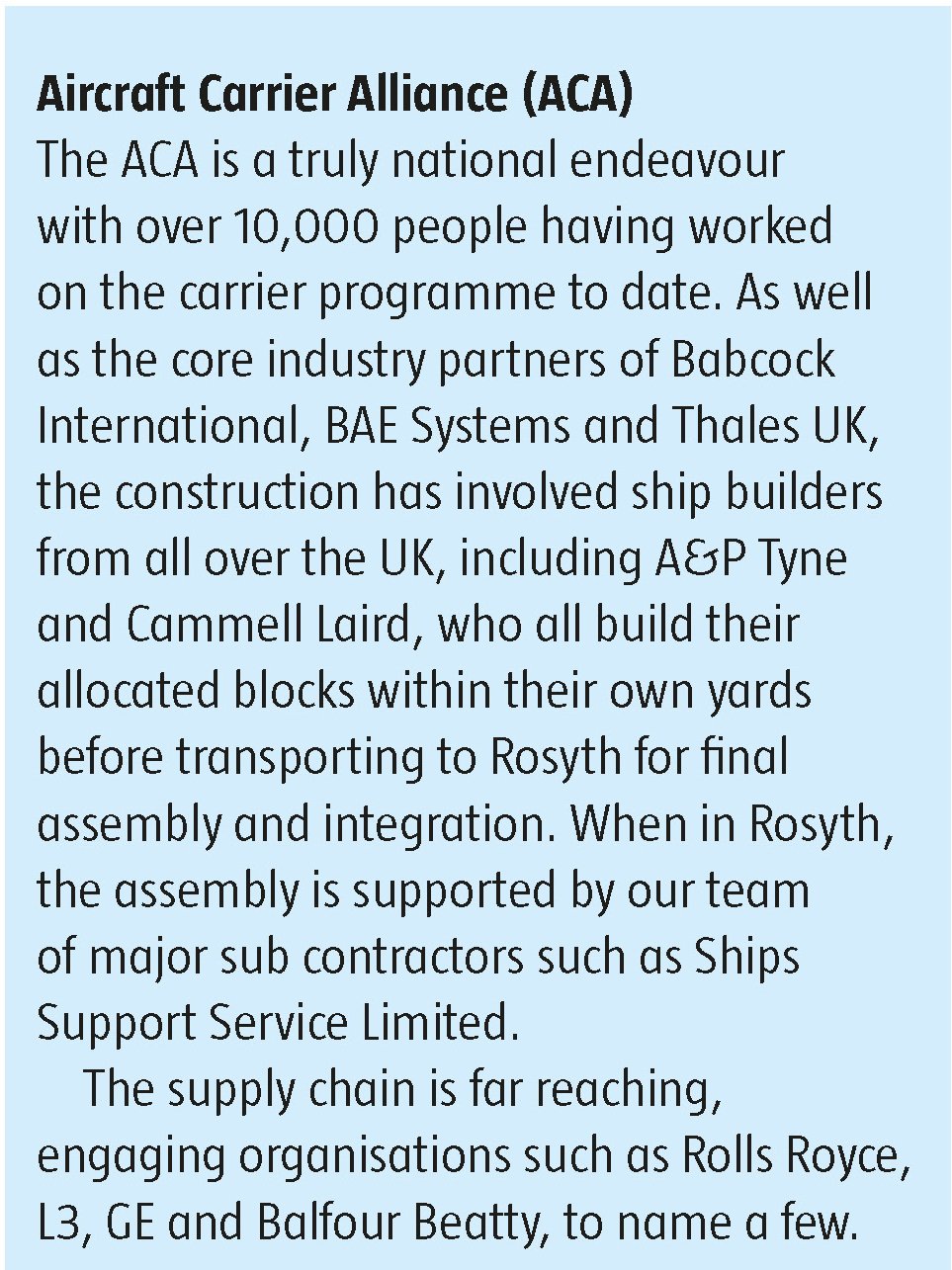
Building the UK’s biggest ever warships has been an undertaking that has required building an alliance of three industry partners across multiple sites in the UK. Andy Forbes explains how they’ve built in safety best practice as standard.
Forming an alliance with a number of Blue Chip organisations, including BAE Systems, Babcock International and Thales UK, with the task of building something that has never been built before in the UK – a 65,000 tonne aircraft carrier – presented a few safety related challenges.
To tackle these effectively, a safety, health & environmental (SHE) steering group was formed prior to the assembly phase. This was chaired by Sean Donaldson, Aircraft Carrier Alliance (ACA) site operations director, and supported by the ACA’s managing director Ian Booth, as well as the ship delivery directors, the heads of SHE delivery from Babcock and BAE Systems and the MoD.
The primary role of this group is to promote a sustainable SHE culture across all ACA yards by ensuring:
- SHE is considered in all decisions and throughout the design, planning, construction and acceptance phases of the programme.
- SHE risks are assessed and managed in a consistent manner.
- SHE performance is continually monitored against targets and reported.
- Leading indicators are used to identify risks and measures taken to prevent accidents.
- Best practice and lessons learnt are shared across the ACA and key suppliers.
- Leaders demonstrate their commitment in support of the above.
Bench marking
The project gave us all an opportunity to learn from each other by adopting best practice along the way. At times it became difficult to know what best practice is so we agreed the ACA best practice process, which allowed us to make jointly informed decisions. Once in place it took away a lot of the emotion, enabling us to focus on development and deployment. It was clear that we were all on similar journeys, wanting the same things just at different stages of the glide path.
In understanding and delivering best practice it was important to look outside of the ship building community. At the time Lawrence Waterman was overseeing the now very successful construction of the Olympic Village. Our time with the Olympic Delivery Authority was invaluable, enabling us to further understand the importance of strong branding and focused communications, proactive health and wellbeing measures and a strong assurance and governance framework backed up by a decision making body.
As a result, the ACA SHE strategy was published capturing our intentions towards creating a safe environment for all.
Doing the basics brilliantly
Prior to the blocks arriving in Rosyth for final assembly, it was clear that we must have common standards around our high risk operations. Our bench marking and sharing of best practice had enabled us to develop a set of common standards supported by a suite of key performance indicators which formed very meaningful assurance toolsets. The standards mirrored the risk profile presented by the build phase with confined spaces, lifting, work at height, hot work, control of contractors, housekeeping, transport, chemical management etc. in the assembly phase. Looking ahead we have deployed, lock out tag out, ship haz, in support of the test and commissioning phase with sea trails, etc. in the latter phase.
One area worth noting was the mobilisation of employees from different parts of the UK. An example was BAE Systems who identified risks associated with fatigue given that the journey time to work may increase while working in Rosyth. Using HSE’s fatigue & risk index, BAE Systems put in place a framework to ensure employees would know when they were required to lodge overnight or take dedicated transport. It also highlighted the need for training to help employees understand and how to combat the effects of fatigue. This led to better work scheduling and meant ensuring that higher risk activities that required high levels of concentration were scheduled in the first two thirds of the shift patterns. The data also highlighted the potential for employees to go up to 14 hours without any food, so free breakfasts were put on for all those coming onto their shift to help fuel up.
Operational competence is captured through essential knowledge-based training. This is delivered through the ACA SHE passport scheme which specifies what standard of training (bronze, silver or gold) is required subject to the tasks involved and its inherent risks. For example, those engaged in hot work while working at height or in a confined space will require a gold passport. This ensures that they will have received specific training regarding the hazards associated with their task, and more importantly the control measures to adopt in both normal and emergency situations.
Another example could be personnel who require access to systems on board ship. In this instance, a silver plus is required which ensures all they need to know about the hazards on board ship as they access and egress their particular work area. The passport doesn’t just extend to tradesmen and women but also supervisors and managers. Ian Booth, ACA managing director, has made it very clear the standards he expects on board which extends to all persons, including Royal Navy staff.
Making the connection – proud to be safe
Given that the workforce is a mixture of alliance employees and that the risk profile changes day to day it was important to ensure ongoing and regular engagement. To do this we deployed a simple strategy which focused on effective communication, employee engagement, hazard observation, employee ownership and responsibility and accountability, as well as behavioural safety training.
Part of the success has been down to each employee making the connection between the responsibility they have to themselves and their ACA colleagues. To do this we expect each employee in the assembly area to undertake a risk assessment prior to work commencing known as the point of work safety assessment (POWSA). Should there be an unsafe condition or tasks that require unsafe activity, then the message is clear, adopt a ‘that’s not right’ process and stop work, reporting the concerns immediately to their team leader.
Another area which has contributed to the success of the programme is the intervention presentations. These are conducted by presenters who themselves have either suffered personal injury or loss as a result of an accident. One example is Jason Anker, who fell from a three-metre roof fracturing his spine. Jason presents a very frank and honest account of life in a wheelchair and the ripple effects still felt today by his family and friends.
More recently, the intervention training has taken on a new approach using actors to play out scenarios allowing attendees to see first-hand what makes a positive intervention, equipping them with the skills and confidence to intervene.
 Single points of truth
Single points of truth
Robust integrated planning and assurance is vital on a complex programme, which is why we adopt a variety of different approaches. This is necessary in order to provide a culture where everyone is comfortable to report their concerns, knowing it will be dealt with in a fair and just manner.
Readiness reviews
Prior to the launch of any new activity that presents significant risk, a readiness review is undertaken. A typical example was prior to flood up and movement of the HMS Queen Elizabeth from the dry dock to J & K berths. A team of experts was assembled with clear instructions to assess all residual risk, and the ship movement was successful.
SHE process confirmations
We currently adopt a tiered approach to SHE assurance, which includes SHE process confirmations. This involves all team leaders verifying all POWSAs within the first hour of the shift commencing, with routes of escalation to the ships’ plan of the day if unresolved.
Workplace inspections are conducted by the joint site safety, health, environment & fire team (SHEF) which are timetabled in accordance with the risk/build profile. Again issues that cannot be resolved are escalated to either the ships’ plan of the day or the ships’ SHE committee forum.
High-risk operations audits are conducted by the zone managers using the best practice KPIs. Deep dives are undertaken by the joint governance cell using their subject matter domain knowledge.
In addition to all the above the Babcock Rosyth site is accredited to OHSAS 18001 and as such undergoes a regular surveillance visit from the accrediting body Lloyd’s Register Quality Assurance and all actions relating to the QEC assembly are captured in the Babcock SHE management system AIRSWEB.
In addition to surveillance type activity, each area operates a significant risk register which enables us to trend areas of concern while looking ahead to the future.
 Learning from experience
Learning from experience
To create a true culture of everyone being ‘proud to be safe’, every accident is seen as a real opportunity to improve, which is why we needed to create an environment where everyone feels comfortable reporting. In doing so, we also needed to ensure the root causes were established and addressed in real time. This remains an improving picture which has resulted in a fundamental review of Queen Elizabeth accident causation to help improve Prince of Wales performance.
Real-time reporting has also been a challenge but over the years we have become very effective in deploying safety alerts within 48 hours, supported by short-term mitigation measures. In addition, a common approach to toolbox talks across the industry partners has helped cascade the learning, and where required we have stood down the whole workforce to address trends in our performance.
Leadership
Leadership is one of the most significant parts of our strategy. The senior leadership team all have safety responsibilities which are captured in the ACA SHE strategy and are taken very seriously.
They are visible and very engaging in their approach, regularly walking the ship accompanied by members of the safety, health, environment & fire team. They are often first on scene following any major incidents, helping to contain the incident before supporting the counter-measures required.
A recent example was on the Queen Elizabeth. As we entered the test and commissioning phase, the ACA SHE steering group was seeking assurance that it was safe to proceed regarding high voltage work and live testing.
Following a review of the data and a healthy debate, the whole schedule was moved two months to the right in order to allow time to deploy the required actions.
Just culture
Over the years we have been able to develop a culture where people accept discipline and enforcement in the same way as reward and recognition. It’s said quite often that if people don’t want to work safely, it doesn’t make them a bad person, it just means there isn’t room for them on the ACA carrier programme.
The approach to understanding whether something is fair and just has been agreed with the main trade unions and is applicable to anyone working on the QEC programme regardless of seniority and rank.
Andy Forbes is head of SHE and security for the Aircraft Carrier Alliance in Rosyth Dockyard
The Safety Conversation Podcast: Listen now!
The Safety Conversation with SHP (previously the Safety and Health Podcast) aims to bring you the latest news, insights and legislation updates in the form of interviews, discussions and panel debates from leading figures within the profession.
Find us on Apple Podcasts, Spotify and Google Podcasts, subscribe and join the conversation today!




